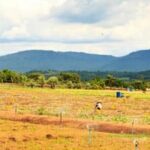What is backyard vegetable gardening? Backyard vegetable gardening is the practice of growing fruits, vegetables, and herbs in your own backyard. This method of gardening has been gaining popularity in recent years as people seek a more sustainable and healthy lifestyle.
Not only does it provide fresh and organic produce, but it also offers a range of other benefits. More and more individuals are turning to backyard vegetable gardening as a way to connect with nature, reduce their environmental impact, and enjoy the therapeutic effects of working in the garden.
The surge in interest in homegrown produce can be attributed to various factors, including concerns about food security, health, and the environment. With the increasing availability of information and resources on backyard vegetable gardening, more people are discovering the joy and satisfaction that comes with growing their own food.
In this article, we will explore the ins and outs of backyard vegetable gardening, from getting started to troubleshooting common issues. Whether you’re a complete beginner or an experienced gardener looking for new ideas, there’s something for everyone in the world of backyard vegetable gardening.
In the following sections, we will delve into topics such as choosing the right location for your garden, preparing the soil, selecting the right vegetables to grow, planting seeds or seedlings, watering and fertilizing, managing pests and diseases, seasonal considerations, harvesting your produce, sustainability and environmental benefits, community aspects of gardening, as well as troubleshooting common issues.
By the end of this article you’ll have a comprehensive understanding of what it takes to start your very own backyard vegetable garden.
Getting Started
Once you’ve selected the perfect spot for your garden, it’s time to prepare the soil. This involves removing any weeds or debris, loosening the soil, and incorporating organic matter such as compost or well-rotted manure. This will help provide essential nutrients to your plants and improve overall soil structure. Lastly, selecting the right vegetables to grow is crucial for a successful harvest. Consider factors such as climate, available space, and personal preferences when making these decisions.
Getting started with backyard vegetable gardening also involves understanding the planting and maintenance process. Depending on whether you choose seeds or seedlings, specific care instructions will need to be followed for successful growth. Additionally, proper watering and fertilizing techniques are essential for healthy plant development. Lastly, managing pests and diseases is an ongoing part of gardening, so familiarize yourself with common issues and their solutions to keep your plants thriving throughout the season.
Planting and Maintenance
When it comes to planting and maintenance in your backyard vegetable garden, there are several key steps to keep in mind. Whether you’re starting from seeds or seedlings, it’s important to carefully follow the instructions on the seed packets or plant labels.
When planting seeds, make sure to sow them at the correct depth and spacing, and provide adequate water and sunlight for germination. For seedlings, handle them gently when transplanting into the garden and water them well to help with the transition.
In terms of maintenance, watering is crucial for the health and growth of your vegetable plants. Most vegetables need about 1-1.5 inches of water per week, either from rainfall or watering. It’s important to water deeply but infrequently to encourage strong root development. Fertilizing is also essential to provide necessary nutrients for your plants. Consider using natural fertilizers like compost or organic products, and follow recommended guidelines for application frequency.
Another aspect of maintenance is managing pests and diseases that can harm your vegetable plants. Regularly inspect your garden for signs of insect damage or disease, and take appropriate action if needed. This might include using natural pest control methods like introducing beneficial insects or handpicking larger pests like caterpillars. Ensuring good air circulation around plants can also help prevent some common diseases.
| Planting Tips | Maintenance Tips |
|---|---|
| Follow proper depth and spacing when planting seeds | Water deeply but infrequently to encourage strong root development |
| Gently transplant seedlings into the garden | Fertilize with natural products like compost or organic fertilizers |
| Provide adequate water and sunlight for germination | Regularly inspect garden for signs of pests or disease |
Seasonal Considerations
When it comes to backyard vegetable gardening, understanding and adapting to seasonal changes is crucial for a successful harvest. Whether you are planting in the spring or fall, each season presents its own set of challenges and opportunities for your garden. Here are some key seasonal considerations to keep in mind:
- Spring planting vs. fall planting: Understanding the best timing for planting your vegetables is essential. Spring is the ideal time for planting warm-season crops such as tomatoes, peppers, and cucumbers. On the other hand, fall is perfect for cool-season crops like lettuce, carrots, and spinach.
- Cold-weather gardening tips: As the temperatures drop, it’s important to protect your plants from frost and freezing conditions. Consider using row covers or cold frames to extend your growing season into the colder months.
- Summer harvesting and maintenance: Once summer arrives, regular maintenance becomes crucial. Be vigilant about watering and weeding, and keep an eye out for pests and diseases that tend to thrive in warmer weather.
By understanding these seasonal considerations and making appropriate adjustments to your gardening practices, you can ensure a bountiful harvest throughout the year.
Ultimately, successful vegetable gardening requires adaptation to the changing seasons. By being proactive in addressing seasonal challenges and taking advantage of seasonal opportunities, you can maximize the productivity of your backyard garden while enjoying a variety of homegrown produce year-round.
Harvesting and Enjoying Your Produce
Once your vegetables are ready for harvest, it is important to pick them at the right time to ensure optimal flavor and nutrition. Different vegetables have different indicators of ripeness, so it’s essential to research each type you’re growing. In general, vegetables are best harvested in the morning when their water content is highest. Use clean, sharp gardening shears or scissors to avoid damaging the plants.
Using and Enjoying Your Homegrown Vegetables
One of the most rewarding aspects of backyard vegetable gardening is being able to enjoy the fruits of your labor. There are countless ways to use and savor your homegrown produce – from creating fresh salads, stir-fries, and soups to incorporating them into various recipes. You can also consider preserving your excess produce by canning, freezing, or pickling to enjoy during the off-season.
Importance of Preserving and Storing Excess Produce
When you have an abundance of vegetables from your garden, it’s important to preserve and store them properly to avoid waste. Canning, freezing, dehydrating, and pickling are popular methods for preserving excess produce. Furthermore, proper storage techniques such as using root cellars or refrigeration can help extend the shelf life of your homegrown vegetables. By learning how to preserve and store your excess produce, you can continue enjoying the rewards of your garden long after harvesting season has ended.
Sustainability and Environmental Benefits
Backyard vegetable gardening not only provides fresh and nutritious produce, but it also offers a range of sustainability and environmental benefits. By growing your own vegetables at home, you can significantly reduce your carbon footprint and contribute to a healthier planet.
Environmental Impact
Backyard vegetable gardening helps reduce the demand for commercially-grown produce, which often involves extensive transportation and storage that contribute to greenhouse gas emissions. By growing your own vegetables, you can cut down on the use of fossil fuels and decrease the overall carbon footprint associated with food production.
Benefits of Reducing Food Miles
One of the key environmental advantages of backyard vegetable gardening is the reduction in food miles – the distance that food travels from the point of production to consumption. By cultivating your own vegetables in your backyard, you can eliminate the need for long-distance transportation, thereby reducing fuel consumption and air pollution associated with shipping and distribution.
Organic Gardening Methods
Another important aspect of sustainability in backyard vegetable gardening is the use of organic methods. By avoiding synthetic pesticides and fertilizers, you can minimize water pollution, protect beneficial insects and wildlife, and promote healthy soil ecosystems. Organic gardening practices also contribute to a more sustainable and balanced environment by reducing chemical inputs into the ecosystem.
Community and Social Aspects
Backyard vegetable gardening not only provides a source of fresh, healthy produce but also offers opportunities for community engagement and social interaction. Engaging with neighbors or joining community gardening groups can help foster a sense of community and collaboration. Here are some ways in which backyard gardening can contribute to the social fabric of your neighborhood:
- Engaging with neighbors or community gardening groups: Participating in or starting a community garden project can bring people together to work towards a common goal. It provides an opportunity for members of the community to connect, build relationships, and share knowledge and resources.
- Sharing and trading produce with friends and family: Excess produce from backyard gardens can be shared with friends, family, or neighbors. This fosters a spirit of generosity and sharing within the community, and it allows people to enjoy a variety of homegrown vegetables.
- Building a sense of community through gardening: Working on a common gardening project can create a sense of belonging and participation within the local community. It provides a platform for people to come together, share experiences, and support each other in their gardening endeavors.
In addition to these direct interpersonal benefits, backyard vegetable gardening also has the potential to contribute to broader community goals such as food security, sustainability, and environmental stewardship. By coming together to grow food locally, communities can reduce their reliance on long-distance food transportation while promoting healthier lifestyles through increased access to fresh produce. Furthermore, when practicing organic gardening methods, individuals can collectively minimize their environmental impact by reducing chemical use and preserving biodiversity in their local ecosystems.
Ultimately, backyard vegetable gardening offers much more than just delicious fruits and vegetables; it provides an opportunity for individuals to connect with their communities, strengthen social ties, and work towards shared goals related to health, sustainability, and environmental well-being.
Troubleshooting Common Issues
In conclusion, backyard vegetable gardening is a rewarding and beneficial activity that continues to gain popularity. Not only does it provide individuals with a sustainable source of fresh produce, but it also offers numerous environmental and social advantages. By following the steps for getting started, planting and maintenance, seasonal considerations, harvesting, and troubleshooting common issues outlined in this article, individuals can enjoy a successful garden that brings them joy and satisfaction.
Furthermore, backyard vegetable gardening allows individuals to contribute to sustainability efforts by reducing food miles and practicing organic gardening methods. The act of growing one’s own food also fosters a sense of community and social engagement, whether through interactions with neighbors or participating in community gardening groups. Sharing produce with friends and family not only reduces waste but also creates opportunities for connection and camaraderie.
Lastly, while challenges may arise in the process of backyard vegetable gardening, it is important for individuals to seek help when needed. By asking for advice from experienced gardeners or utilizing online resources, many common issues can be addressed effectively. Overall, engaging in backyard vegetable gardening is a fulfilling endeavor with far-reaching benefits for both individuals and their communities.
Frequently Asked Questions
What Is the Meaning of Backyard Garden?
A backyard garden refers to a small, private garden located in the back of a home. It is typically used for growing flowers, vegetables, herbs, or fruits for personal use and enjoyment. Backyard gardens can be a place for relaxation, recreation, and connecting with nature.
What Is the Meaning of Vegetable Garden?
A vegetable garden is a dedicated area for growing various types of vegetables. It can be located in a backyard, community garden, or even on a balcony or rooftop. Vegetable gardens are popular among those who want to grow their own fresh produce and have control over the quality of the vegetables they consume.
How Do I Start a Backyard Vegetable Garden?
Starting a backyard vegetable garden can be an enjoyable and rewarding experience. First, it’s important to choose a sunny spot in the yard that receives at least 6-8 hours of sunlight per day. Then, prepare the soil by loosening it and adding compost or organic matter to improve fertility.
Next, decide which vegetables you want to grow based on your climate and available space. Finally, plant your chosen vegetables and provide regular care such as watering, fertilizing, and pest control to help them thrive. With time and effort, you can enjoy delicious homegrown produce from your own backyard garden.

If you’re looking to get into vegetable gardening, or are just looking for some tips on how to make your current garden better, then you’ve come to the right place! My name is Ethel and I have been gardening for years. In this blog, I’m going to share with you some of my best tips on how to create a successful vegetable garden.





